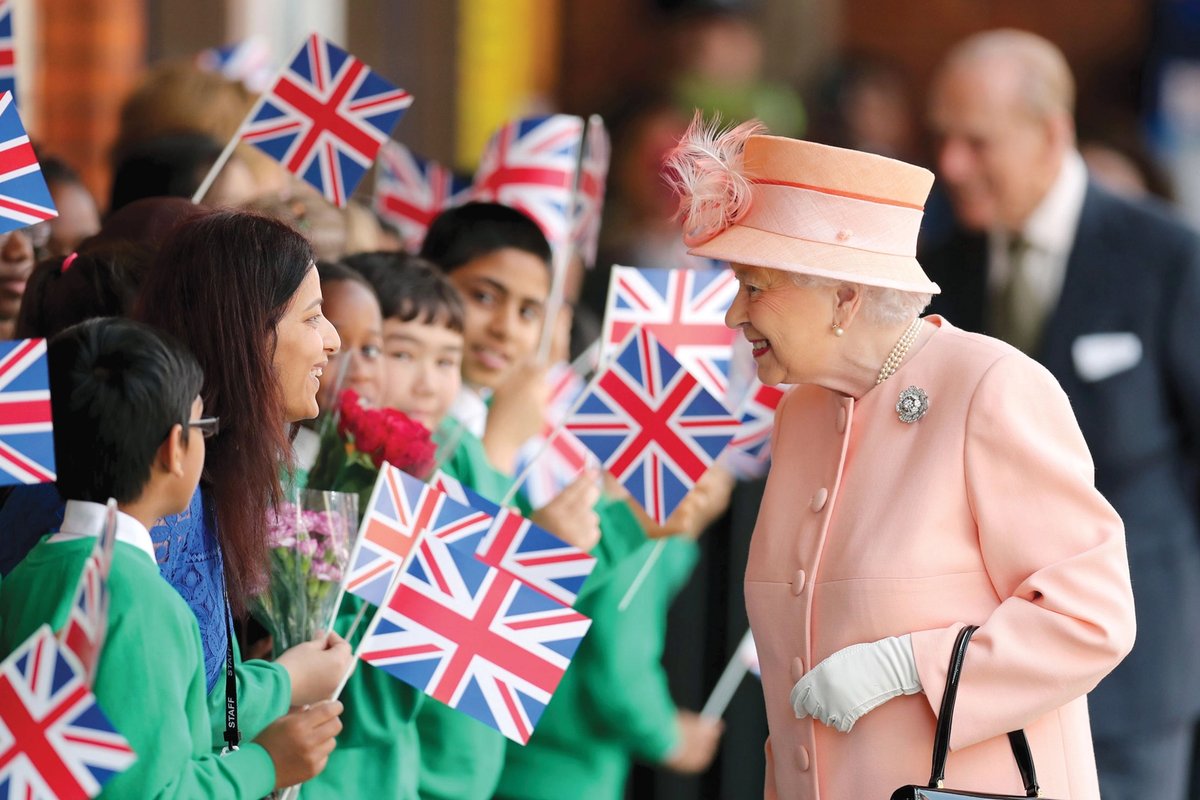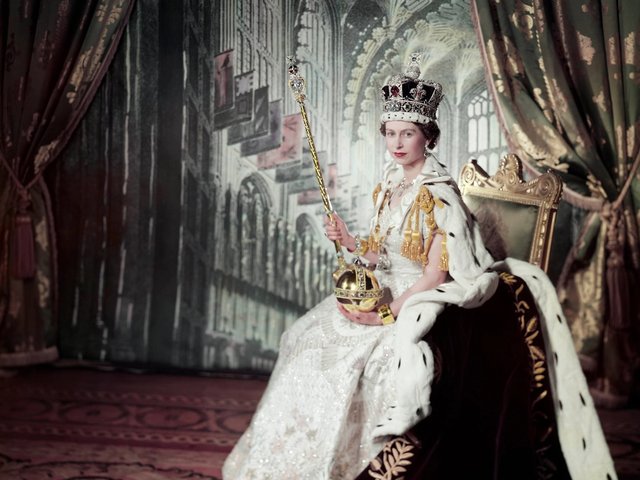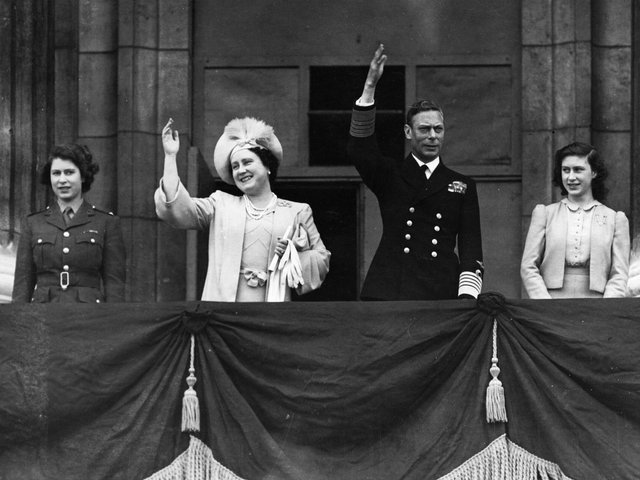The controlled, carefully evolving, global visibility of Queen Elizabeth II was one of the great demonstrations of durational performance art. It was a feat made all the more remarkable by the consistency and longevity of its development, made possible by the Queen's powers of concentration, stamina and presence of mind. She became a Marina Abramovic for the ages.
The British monarch played multiple roles as national mother, head of state, constitutional monarch, titular commander in chief of all British forces; an emblem of value on currency and postage stamps, a sitter in countless official portraits, a dignified processional and ceremonial performer; and patron of more than 600 charities, military associations, professional bodies and public service organisations.
She was a cultural celebrant attending royal command performances of theatre, film, dance and music—her encounter with Marilyn Monroe, the “Queen of Hollywood”, at a film premiere in 1956 produced one of the great news pictures of her reign—and opening new arts buildings, including the Royal National Theatre, London, in 1976, and the Sainsbury Wing of the National Gallery in 1991. She even figured in many of her subjects’ dreams—as an unexpected guest to tea, and thus as an unwitting symbol of domestic and cultural panic.
Her life as Queen was a performance face-to-face with the public, in person or on television or online, akin to a long-range version of Marina Abramovic’s The Artist is Present (2010)—where Abramovic sat in place for three months, eight hours a day, while a succession of visitors to the Museum of Modern Art, New York, came to sit opposite her. ”It was a complete surprise,” Abramovic said, “this enormous need of humans to have contact”. But in the Queen’s case, answering the need of humans to have contact, to engage with her, lasted not for three months, but for more than 70 years.
The evolution will be televised
The Queen's coronation in 1953 was a ground-breaking live broadcast—one in which the mystery of monarchy became part of a shared national, and international, experience, revealing far more than the brief newsreel of her father George VI’s crowning in 1936. Televisions, with their tiny screens—at best 12 inches across the diagonal—were still a luxury in the early 1950s. But television sales and rentals grew in the lead-up to the coronation and it was estimated that during the ceremony, each television set in Britain was watched by an average of 17 people, with a total audience of more than 20 million viewers (a further 10 million listened on radio).
Watching the television footage of the coronation nearly 70 years after the event, it is remarkable how little the Queen’s performance has dated. The core ritual of coronation feels timeless, with several episodes of pure theatre
Watching the television footage of the coronation nearly 70 years after the event, it is remarkable how little the Queen’s performance has dated. The core ritual of coronation—proceedings conducted at an unerring military pace that showed the influence on proceedings of the Queen’s naval officer husband Prince Philip and the formidable Earl Marshal, Bernard, Duke of Norfolk—feels timeless, with several episodes of pure theatre. The first, is when the Queen enters the nave of the abbey with the officials carrying the regalia of office—crown, orb and sceptre—and the choir sings out “Vivat Regina! Vivat!” with stinging power. Then there is a scene of near-operatic drama when four times the Queen is echoingly acclaimed —”Long live Queen Elizabeth”—as she turns to the four points of the compass, at each iteration sweeping back her cloak with a shallow curtsey, half swaying on her hips in response to each of four forceful acclamations.
She bears an ever greater physical weight, a metaphor for the psychological weight of her office-for-life, as she is invested with all four layers of coronation robes and the regalia of office: the orb; the wedding ring of England; the white glove; the sceptre, containing the 530-carat Star of Africa, cut from the Cullinan Diamond presented to Edward VII in 1907; and the rod. Then she puts on the Imperial State Crown, adorned with the second Star of Africa diamond, a 320-carat gem also cut from the Cullinan; the Black Prince's ruby; and ”Queen Elizabeth I's pearls”, four enormous pear-shaped jewels, hanging at its heart.
From beginning to end the young Queen performed an emotionally, historically and physically burdensome ceremony with serene gravity, in what felt like a rehearsal, physical and metaphorical, for the seven decades on public display that lay ahead of her.
A symbol of international prestige
The Queen assumed the monarchy when Britain was still mired in postwar austerity, a colonial and military power on the wane, and many of her early overseas visits featured independence ceremonies for the country’s former colonies. These visits, carried out at the government’s request, and starting with the Queen and Prince Philip's six-month tour of the Commonwealth from November 1953 to May 1954, were a conduit of soft power that helped maintain the country’s prestige whatever the diminution of its economic and military power.
In the succeeding seven decades the royal couple made a number of state visits of enormous symbolic significance, designed to reinforce important alliances or to ease historic tensions. In 1986 they visited China and Hong Kong during negotiations to return Hong Kong—a British colony from 1841 to 1947—to Communist Chinese rule. In 1994 they were President Boris Yeltsin’s guests in Russia, to promote trade between the two countries, five years after the fall of the Soviet Union and 76 years since the murder of the Queen’s cousin Tsar Nicholas II and his family. In 1995 they were guests of President Nelson Mandela, the year after his election, in their first post-apartheid state visit to South Africa. And in 2011 they made a state visit to Ireland of great historic significance.
The Queen and Prince Philip return to Britain at the end of the royal tour of the Commonwealth, in 1954. On board the royal yacht Britannia, the Queen inspects the home fleet off Portsmouth and sails up the Thames to London Basin
The mobile royal vitrine
On public engagements and state visits, Elizabeth moved like a high-functioning clockwork jewel—though one with an expressive, human face—the lead exhibit in a royal showcase that also contained her husband, their hosts, and the royal staff. This group choreography created a mobile vitrine for the royal figure, as much as it provided a means of personal security and good timekeeping.
On public engagements and state visits, Elizabeth moved like a high-functioning clockwork jewel—though one with an expressive, human face—the lead exhibit in a royal showcase
The Queen’s favourite, and largest, travelling showcase was the 414ft royal yacht Britannia, in service between 1954 and 1997. The maiden voyage of the Britannia was to Malta, carrying Prince Charles and Princess Anne to meet their parents and bring them back to London at the end of their Commonwealth tour, with full naval escort. The trip concluded with martial circumstance. The Britannia was greeted by the home fleet, arranged in line off the coast of Portsmouth, firing multiple gun salutes to the returning Queen, before the yacht proceeded to the capital and made a stately, theatrical progress up the River Thames—its banks lined with crowds, a Royal Air Force flypast overhead—and through the open arms of London's Tower Bridge.
The Britannia was used for hundreds of tours in British waters and overseas—including politically charged visits to Hong Kong, Russia, and South Africa—as a mobile palace where the Queen could return her host’s hospitality in suitable fashion, with the yacht’s lights artistically reflected on the sea at night, a show of naval pomp provided by a Royal Marines band, and the particular frisson generated by the whistling on board of the monarch and her guests.
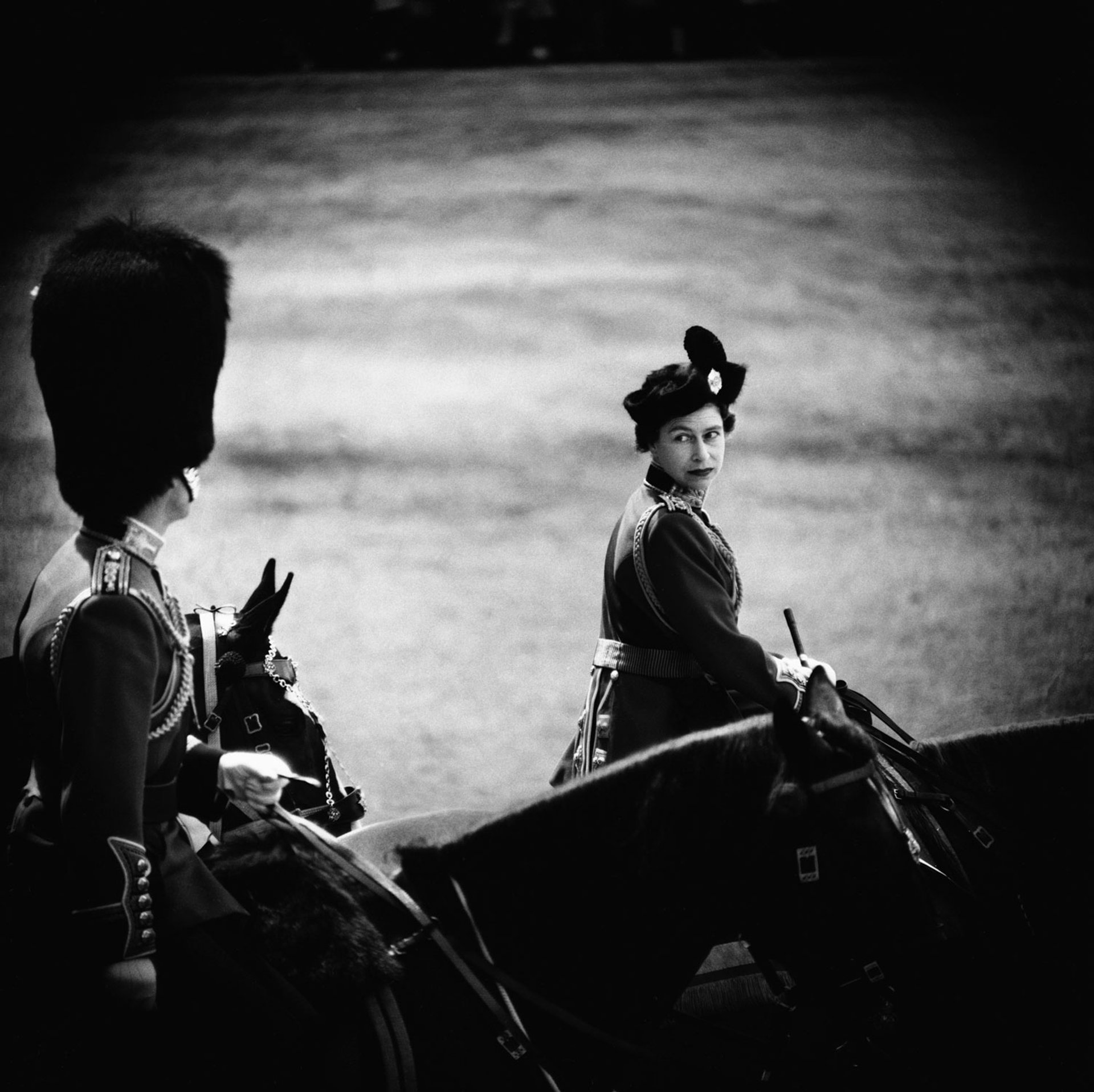
The better to be seen: The Queen turns towards her husband Prince Philip during the 1961 Trooping the Colour ceremony to mark her 35th birthday © Hulton-Deutsch Collection/Corbis/Corbis via Getty Images
A remorseless performance schedule
Besides the official overseas visits, and biennial meeting of the heads of Commonwealth countries, the Queen ran a remorseless home performance schedule, almost permanently on stage, in a series of public engagements fitted in around the hosting of two state visits to Britain each year and participating in annual ceremonial staples. These include the state opening of Parliament; Remembrance Sunday in Whitehall each November; the Christmas Day broadcast; the Trooping the Colour for her official birthday in early June; a series of 4,000-guest garden parties at Buckingham Palace to say thank you to workers at charities and public associations (the bodies that have the Queen and her family as their patrons); and 20 investitures a year, 100 people at a time, when insignia are conferred on people recognised for their contribution to public life—as knights, dames, commanders, officers and members of the Order of the British Empire and other orders of chivalry.
At these investitures the choreography was designed to bring monarch and subject face to face, for precisely the amount of time required for the presenting of insignia or the tapping of a recipient on the shoulders with extended sword, and to answer the human need for contact.
The media monarch
Television made the 1953 coronation a truly shared national experience. The Queen was seen, live on screen by a vast audience, but television has proved to be an unpredictable, uncontrollable, partner over the succeeding decades. It was part of the Queen’s duty to be seen, but that duty had to be held in balance with maintaining the mystique of monarchy.
Royal Family, the first royal television documentary, was shown on BBC and ITV in June 1969. It was commissioned to bring notice to the royal family—whose image had grown fusty in the context of the Swinging Sixties—in the lead-up to Prince Charles’s investiture as Prince of Wales at Caernarvon Castle on 1 July 1969.
At investitures the choreography was designed to bring monarch and subject face to face, for precisely the amount of time required for the presenting of insignia or the tapping of a recipient on the shoulders with extended sword, and to answer the human need for contact
The programme itself is startling, seen through 21st-century eyes, for the untrained openness with which nearly all members of the family move and talk. In the opening scene, the Queen is shown on full public show, riding solo and in full dress uniform, the better to be seen, at the head of the Trooping the Colour, with its panoply of marching guardsmen and brass bands. The scene cuts smoothly to the quiet of the courtyard of Buckingham Palace as the monarch rides in, the ceremonial walking tempo unbroken. And then she dismounts, feeds carrots to her horse in unhurried fashion, before heading into the palace, smiling broadly and greeting and chatting unaffectedly to functionaries and servants as she goes.
To a 1969 audience this was a first view of the monarch as they had never seen her before: a relaxed, witty materfamilias and leader of her household. Some of the conversations captured on camera in Royal Family have not aged well, but it is easy to see now why the programme was a media sensation in its time. By the end of 1969, when both the BBC and ITV re-broadcast the documentary over Christmas, it was estimated that three-quarters of the British population had seen the programme, and there was a fear of overexposure. The Queen’s annual Christmas Day broadcast to the Commonwealth was accordingly replaced with a written statement.
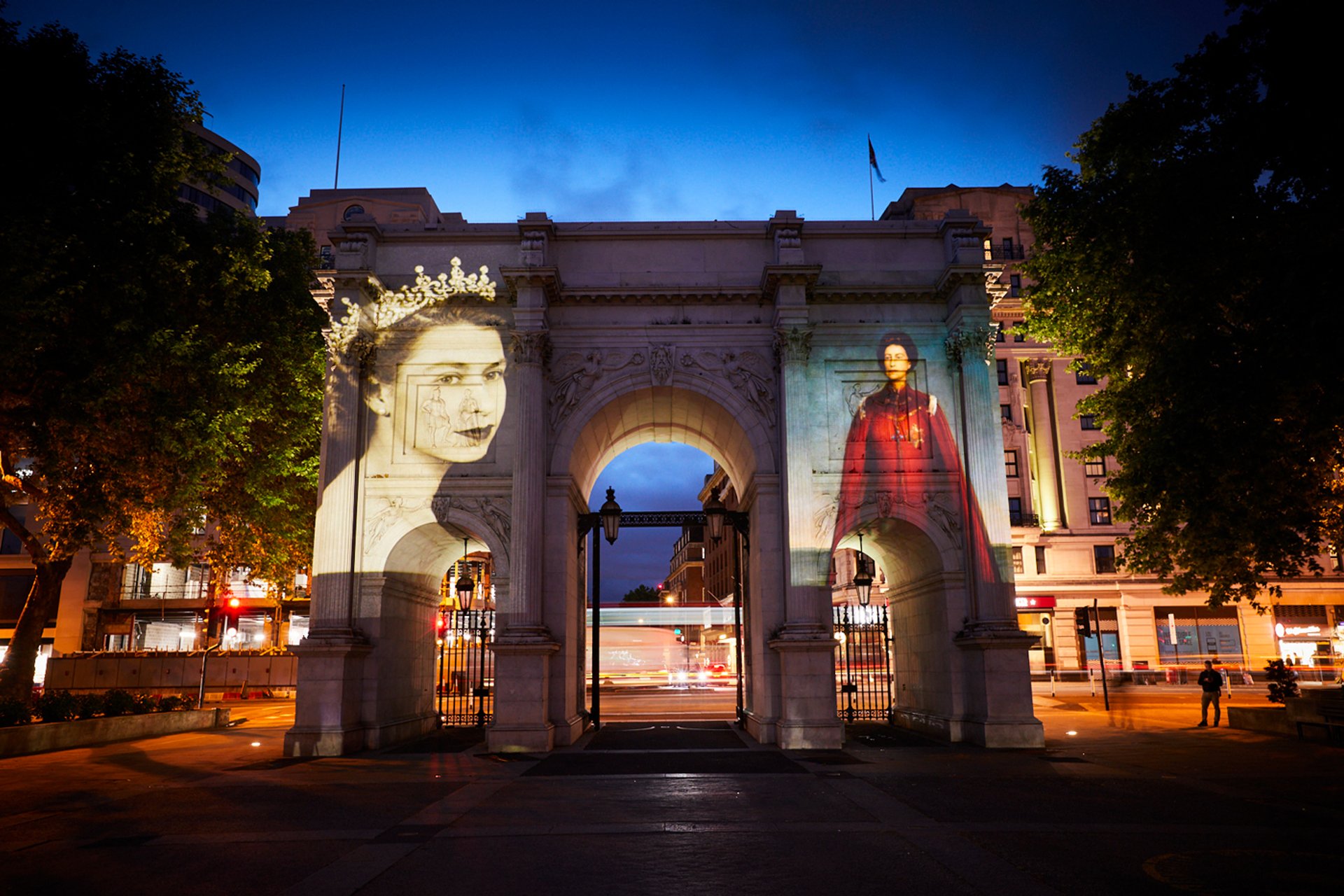
London's National Portrait Gallery projected images of the Queen from its collection on to Marble Arch, one of the city's best-known landmarks, as part of the platinum jubilee celebrations. The images included one of Dorothy Wilding's 1952 portraits (the first official photographs taken of the Queen) and Pietro Annigoni's 1969 portrait of the monarch. The gallery, which is closed for refurbishment, owns 967 images of Elizabeth, and organised the projection in collaboration with the building's custodian, English Heritage Wilding and Annigoni: © National Portrait Gallery; Marble Arch installation: © Michael Pilkington
During her reign, the Queen graduated from radio to television for her annual Christmas address to the Commonwealth, which she kept low-key, with an emphasis on the importance of community, family togetherness and religious faith. But she made unplanned addresses in 1991, at the time of the first Gulf War, in 1997 following the death of her daughter-in-law Princess Diana, and in 2020 in the early months of the global Covid-19 pandemic. Following Diana’s shocking death in a Paris car crash, the Queen and Prince Philip had opted to stay at Balmoral, their Scottish holiday home, to comfort Charles and Diana’s sons, Prince William and Prince Harry, out of the public glare. But after an extraordinary outpouring of public grief, with the laying of fields of flowers outside Kensington Palace and Buckingham Palace, and accusations that the monarch was out of touch, the Queen, Prince Philip and their grandchildren came to London to join the public mourning.
Elizabeth gave a live television address about Diana’s death, with the crowds outside Buckingham Palace visible behind her, in which she said, with clear deliberation: “What I say to you now, as your Queen and as a grandmother, I say from my heart". This series of events—in which the Queen was seen to be finding her way in a challenging public emotional landscape—was the subject of the 2006 film The Queen, in which the title role was played by Helen Mirren.
‘One is a sort of sponge’
In television documentaries shown over four decades—from Royal Family to Elizabeth R (1992), and a six-part series, Monarchy: The Royal Family at Work (2007)—the Queen barely modified the protocol of her repetitive tasks over four decades: most notably the weekly audience with her prime minister at Buckingham Palace. In 2007, as in 1969, she positions herself to the left of two chairs to await the advancing prime minister of the day and shake hands, before motioning her guest to the chair on the left while she takes the seat closer to the fireplace. “They know one can be impartial,” she said in voiceover on Elizabeth R. “One is a sort of sponge [to prime ministers].”
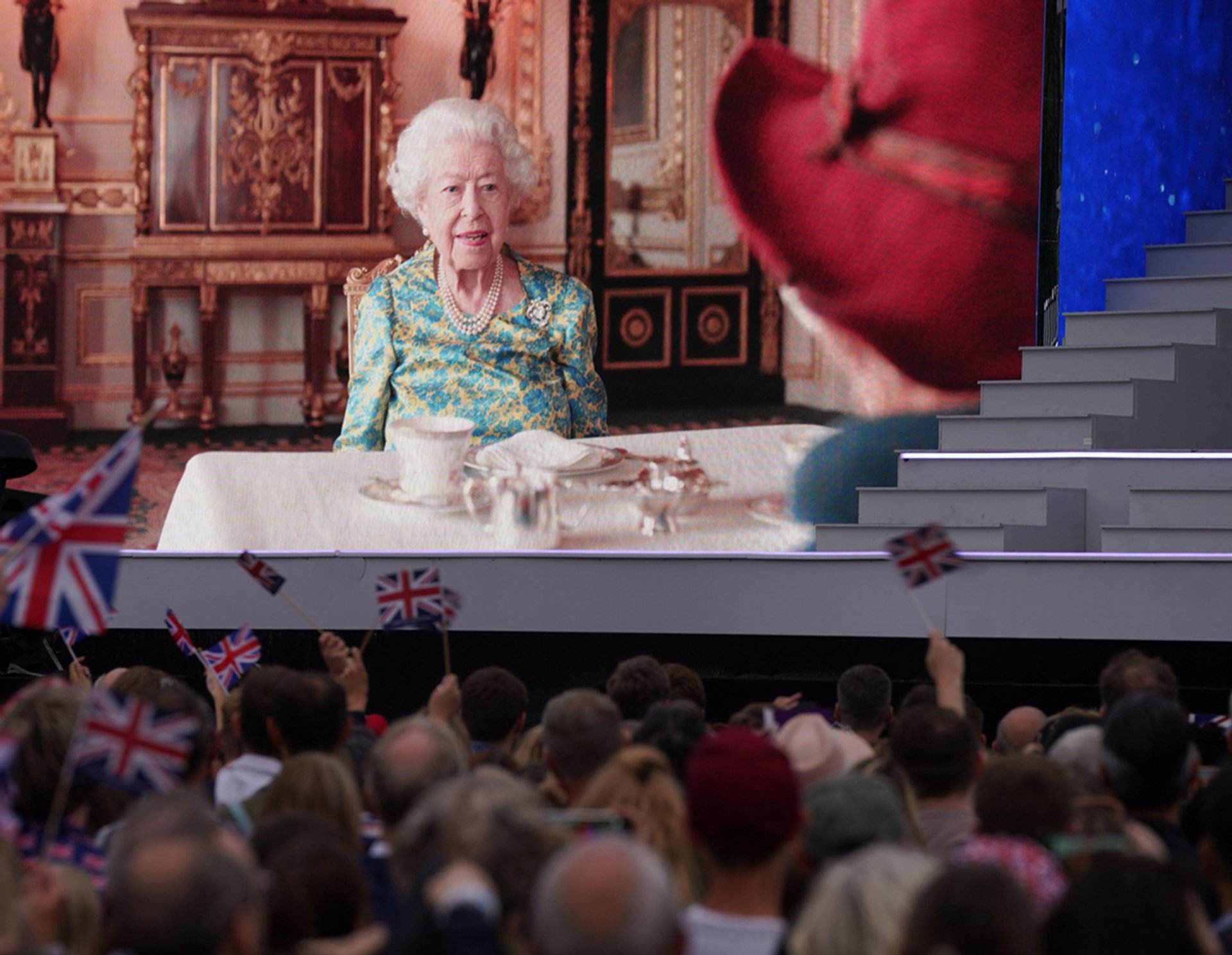
The artist is present 2022: The Queen made a surprise on-screen appearance, in a BBC marmalade-sandwich sketch with the animatronic Paddington Bear, during the Platinum Party at the Palace—part of her jubilee celebrations PA Images / Alamy Stock Photo
Deadpan humour
The Queen was no cultural killjoy, and showed the spirit to film a tongue-in-cheek scene with Daniel Craig as James Bond for the opening of the London Olympics in 2012 (with a stand-in Queen later seen skydiving into the stadium). And her humour has been a useful tool for defusing difficult or awkward situations. When she addressed both houses of Congress during a state visit to the United States in 1991—the day after her face had been obscured while speaking at the White House by a lectern set up to suit her foot-taller host, President George Bush—the Queen’s opening remark, “I do hope you can see me today from where you are”, delivered deadpan, brought laughter and a standing ovation.
It was—like many such moments in the past seven decades—meat and drink to a master in the performance art of monarchy.


